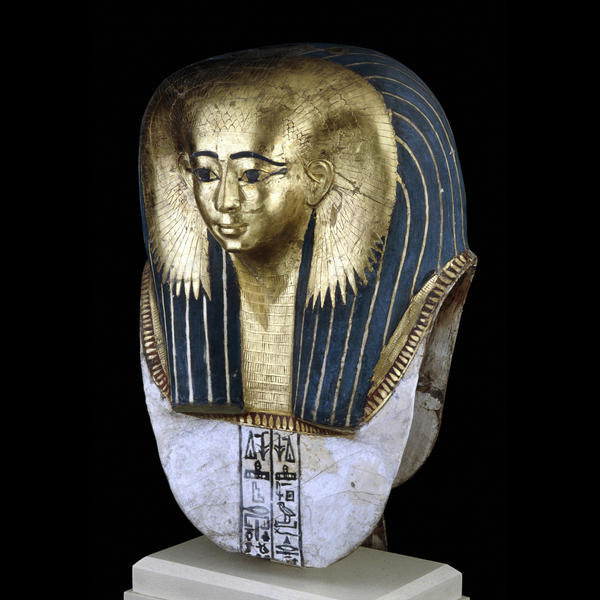 Introduction
to Archaeology and Palaeoanthropology:
Introduction
to Archaeology and Palaeoanthropology:
 Introduction
to Archaeology and Palaeoanthropology:
Introduction
to Archaeology and Palaeoanthropology:
Humanity's Journeys
Dr. Kathryn Denning
Anth 2140, Sept 2005 - Apr 2006
21 Feb 2006... Hi!

Plan for the day
1 Course business/ announcements...
2 Egypt
Reading and Assignments
For today, Feb 21: Fagan Ch 13, Early Asian Civilizations AND ONLINE: Jared Diamond: Why Did Human History Unfold Differently On Different Continents For The Last 13,000 Years? /www.edge.org/3rd_culture/diamond/diamond_p1.html
Tomorrow in Tutorial: Death in Egypt
For next week, Feb 28: Precontact Ontario www.adamsheritage.com/pre/preont1.htm Read each section (tabs along side)
In tutorial next week, Mar 1: MUSEUM ASSIGNMENT IS DUE (posted here) and you'll be discussing Guns, Germs, and Steel (based on Jared Diamond's piece which you read here: www.edge.org/3rd_culture/diamond/diamond_p1.html)
Mar 8 in tutorial - Quiz #5. Review notes to be posted soon.
Museum Assignment - Questions?
E.g.
Q: What parts of the tombs of Hatshepsut (Expedition to Punt) and Kitines should I draw?
A: Any part.
EGYPT
From last class
Ozymandias.... King of Kings...

1817: English poet Percy Bysshe Shelley publishes his sonnet “Ozymandias”
I met a traveller from an antique land
Who said: Two vast and trunkless legs of stone
Stand in the desert. Near them, on the sand,
Half sunk, a shattered visage lies, whose frown,
And wrinkled lip, and sneer of cold command
Tell that its sculptor well those passions read
Which yet survive, stamped on these lifeless things,
The hand that mocked them, and the heart that fed:
And on the pedestal these words appear: ‘My name is Ozymandias, king of kings: Look on my works, ye mighty, and dispair!”
Nothing besides remains. Round the decay
Of that colossal wreck, boundless and bare,
The lone and level sands stretch far away.”
Accurate? Nope. Evocative? Definitely. Revealing of the English perception of Egypt as a place of dead history, surpassed by modern civilization? Just Maybe : )
A few things about Egypt
PLACE

 Nile: 6,825 km long!
Nile: 6,825 km long!


(Museum of Fine Arts, Boston)
below: Nile inundation
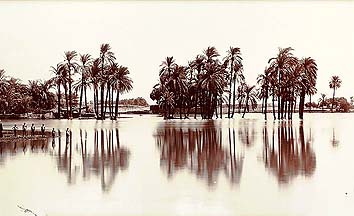
"
| This photo appears to have been taken during the time of the Nile's annual inundation. Rains in the highlands of Abysinnia swelled the Blue Nile, which met the White Nile at Khartoum and sent the rising, silt-laden waters north to cover the fields of Egypt. During the summer months Egypt disappeared beneath the brown waters, the whole of the land a vast sheet of water stretching from desert to desert, with the villages protruding like islands from the flood. In antiquity this was a time of increased navigation, festivals in honor of the inundation, booths and bowers on the edge of the swollen river, and festooned boats upon the waters. Since the building of the High Dam, the inundation no longer occurs in the Nile valley north of Aswan." |
"http://www-oi.uchicago.edu/OI/DEPT/PUB/CATALOG/LE2.2.html
ARCHAEOLOGY
Archaeological bonuses: burial rituals focused on deliberate preservation of bodies and burial goods; excellent natural preservation of sites because of hot, dry, sandy environment.
Other sources for information about the ancient Egyptians:
a) ancient historians, like Manetho, c. 300 BC, Egyptian historian and priest, whose works have not survived intact but are quoted in later historical works, e.g. by Jewish historian Josephus, first century AD.
b) ordinary documents
c) historical inscriptions on monuments themselves; pharaohs were constantly constructing their own histories, tracing lineages, recording their exploits, etc.
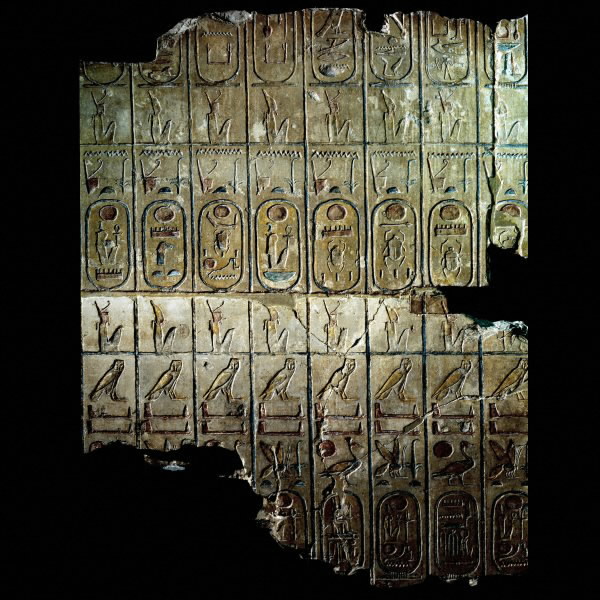
King List: 19th Dynasty, around 1250 BC, chronology of the rulers of Egypt so far, from a temple of Ramesses II.... but it is a selective list.
TIME
A good basic timeline: http://www.bbc.co.uk/history/ancient/egyptians/timeline.shtml
http://www.mfa.org/egypt/explore_ancient_egypt/learn_time.html
Predynastic Period: 5500 - 3100 BC.
0 Dynasty: Unification under Narmer and the Scorpion King.
First Dynasty 3050 - 2890 BC
Second Dynasty 2890 - 2686 BC
OLD KINGDOM: 2686 - 2181 BC. Centralised, unified government. Pharoah started to be divine.
Third Dynasty 2686 - 2613 BC: Djoser builds Step Pyramid at Saqqara.
Fourth Dynasty 2613 - 2498 BC: Khufu (Great Pyramid), Khafre (Sphinz, Second pyramid) and Menkaure build pyramids at Giza.
Fifth Dynasty 2498 - 2345 BC
Sixth Dynasty 2345 - 2181 BC
First Intermediate Period: 7th - 11th Dynasties 2181 - 2055 BC. A mess!
MIDDLE KINGDOM: 2055 - 1650 BC. Unified, prosperous, foreign trade, big building projects.
Mid-Eleventh Dynasty (Mentuhotep I) 2060 - 1991 BC
Twelfth Dynasty 1991 - 1782 BC
Thirteenth Dynasty 1782 - 1650 BC (first half only)
Second Intermediate period 1650 - 1570 BC. Periods of Hyksos rule.
New Kingdom: 1570 - 1070 BC. Again, centralized, unified government.
Eighteenth Dynasty 1570 - 1293 BC: a renaissance of art and building. Tuthmosis (multiple), Hapshetsut, Akhenaten, Tutankhamun
Nineteenth Dynasty 1293 - 1185 BC: Ramesses I, II, III, Seti I and II
Twentieth Dynasty 1185 - 1070 BC: Ramesses IV-XI. breakdown of government. Officials rob tombs and priests assume secular power.
Third Intermediate Period: 1070 - 664 BC. Includes periods of Libyan and Kushite rule.
Late Period: 664-332 BC: Includes periods of Persian rule.
Macedonian and Ptolemaic Period: 332 - 3O BC. Alexander the Great conquered Egypt in 332 BC, built Alexandria. His general Ptolemy I ultimately succeeded him -- and 14 more Ptolemies after that. Rosetta Stone. Cleopatra VII, daughter and co-regent of Ptolemy XII, and sister/co-regent of Ptolemy XIV, ruled Egypt at the end. (Romantic liaisons with Roman rulers Julius Caesar, Marc Anthony.... Rome declared war on Cleopatra/Egypt in 32 BC, and in 30 BC, Octavian, Julius Caesar's adopted son (later known as Roman Emperor Augustus), conquered Egypt and proclaimed himself Pharaoh. Egypt then part of the Roman Empire.
Roman rule: 30 BC - AD 395
Coptic Egypt: Christianity arrived in Egypt around 50AD with St. Mark, and a Christian community started in Alexandria. Eventually there were many (60?) Christian monasteries in Egypt and the religion was generally widespread. Difficulties came when the Romans under Diocletian started to suppress other religions, particularly Christianity. Much martyrdom for a period of about 30 years, 284-313 AD, until the Romans decided on a policy of tolerance again. Christianity continues in parts of Egypt to the present day.
Byzantine: AD 395-640 Ruled from Constantinople, predominantly Christian.
Islamic/Arab Period (Caliphate) Egypt: 640 AD onwards. Ruled from Damascus and from Baghdad.
Ottoman Period: AD 1517-1805. Ruled from Turkey.
Napoleon's expedition: circa 1800, short-lived.
Khedeval Period: AD 1805-1914
British Protectorate: AD 1914-1922
Monarchy: AD 1922-1953
Republic: AD 1953-
made it to here in class on Jan 31
MONUMENTAL ARCHITECTURE
Giza Pyramids: Khufu, Khafre, and Menkaure (left, from right)
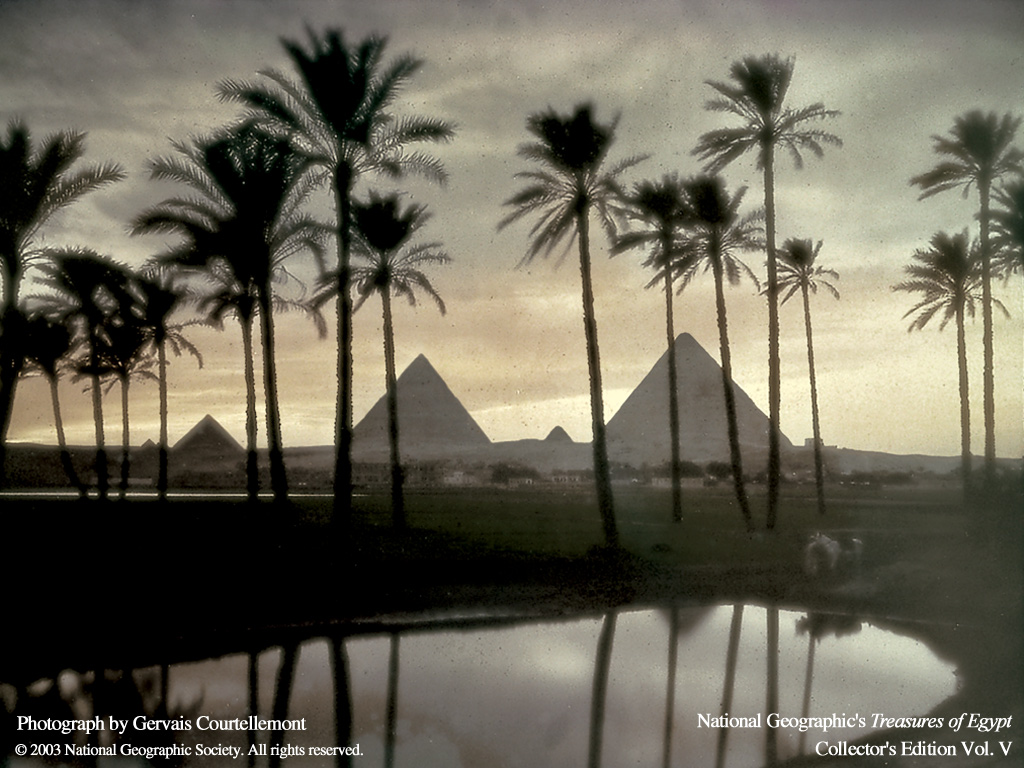
Great Pyramid of Cheops / Khufu
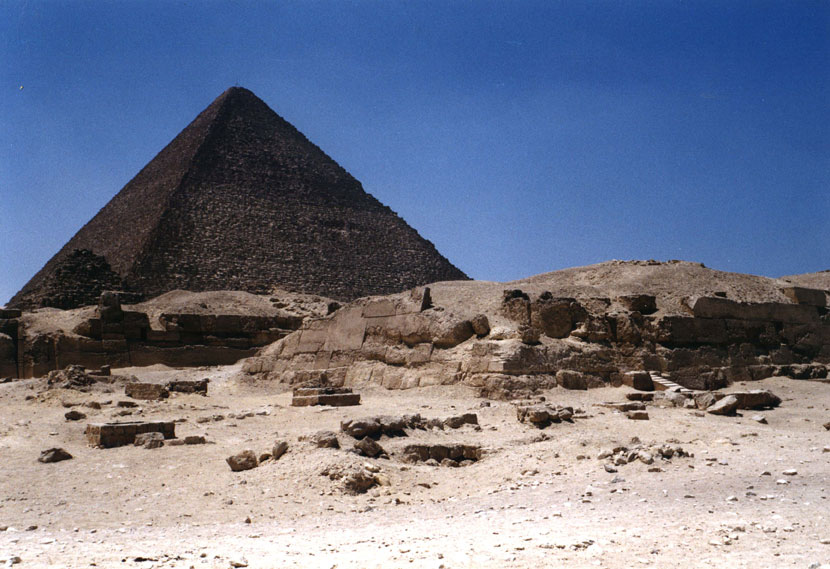
n.b. Photos of the pyramids are sometimes "doctored"
Imhotep (of recent "The Mummy" fame)

Imhotep was actually architect to King Djoser in around 2700 BC.
Imhotep is credited with building the first monumental structure in stone, the Step Pyramid at Saqqara. Much respected as a man of learning, and later revered as a god.
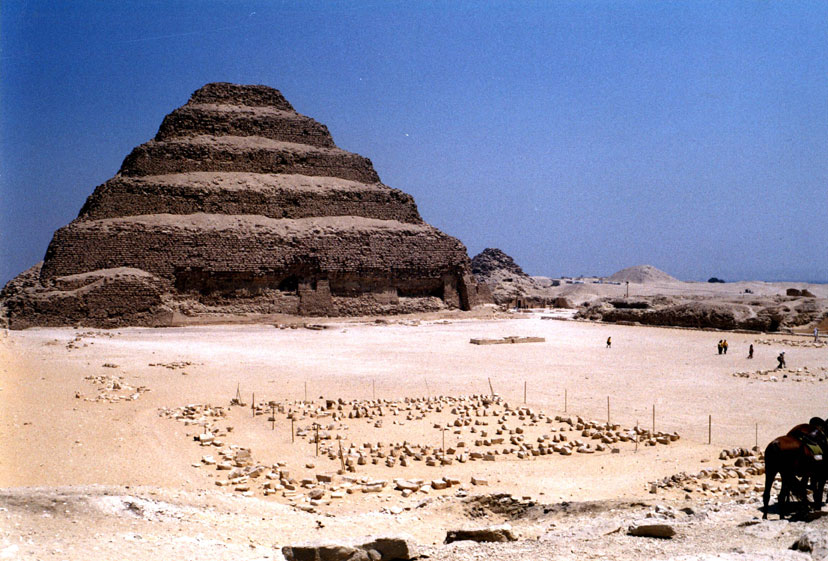
Tomb of Hatshepsut in Deir el Bahri - cut directly into the rock - a lot of it is restoration
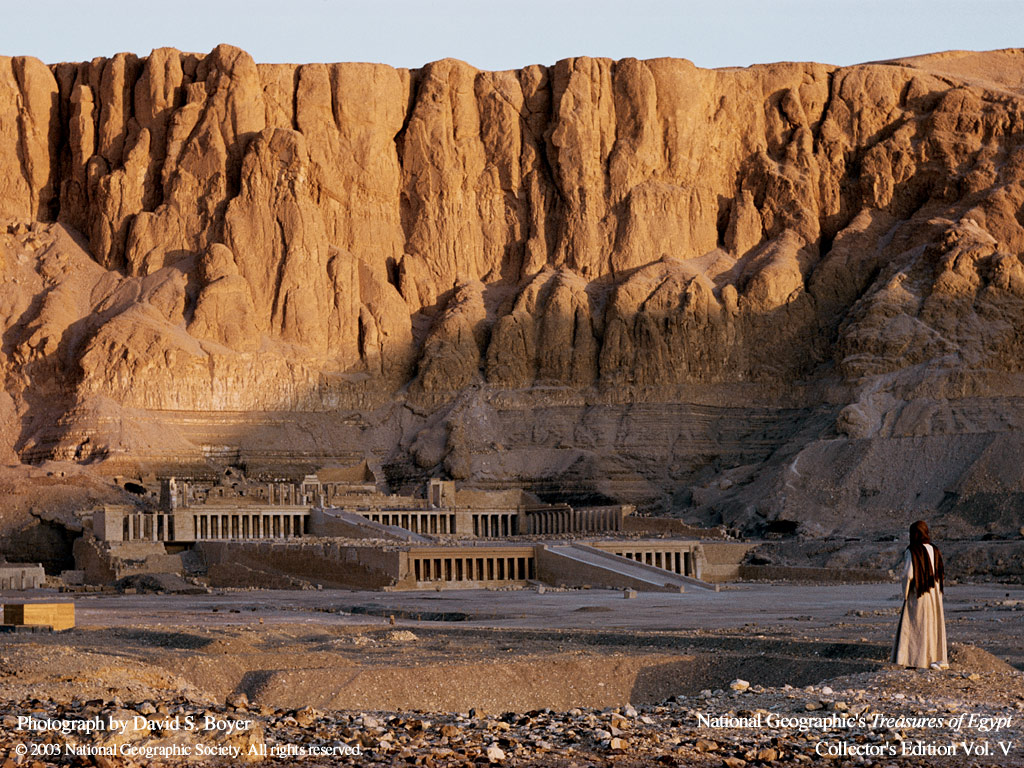
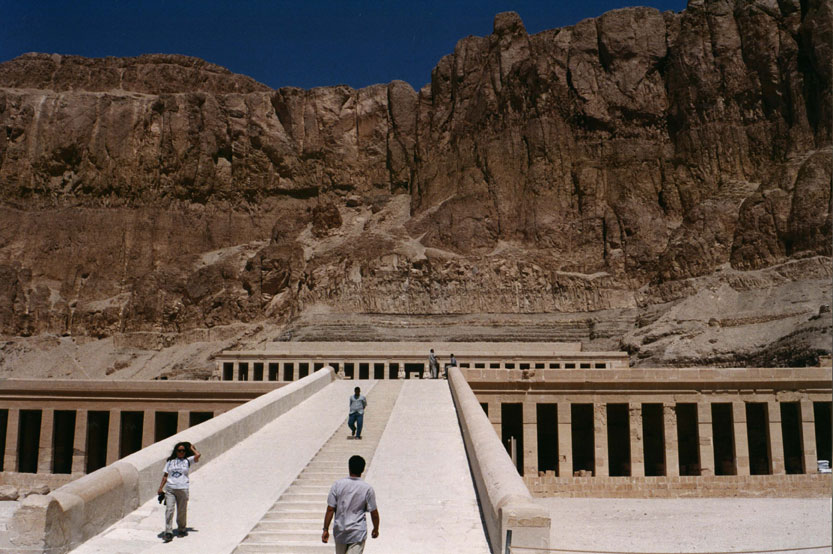
The issue of damnatio memoriae - destroying memory
Reminds us that... ancient people also had a past and a future

Interesting feature of many monuments: reused.
Hemmed in by massive papyrus-bundle columns, this granite colossus was
originally carved for Amenhotep III and two centuries later was recut for
Ramesses II. Standing by the left leg of the king is Queen Nefertari. Of the
eleven surviving standing colossi in the first court at Luxor Temple, five are
statues of Amenhotep III that Ramesses II "renewed" for his courtyard. The reuse
of the monuments of an earlier ruler was not always a hostile usurpation or the
outcome of damnatio memoriae, but could also be a recutting of an ancient
monument in order to renew the creative powers of the temple."
http://www-oi.uchicago.edu/OI/DEPT/PUB/CATALOG/LE2.10.html
Abu Simbel – huge temple, ‘rediscovered’ 1813, cleared of sand in 1817, later relocated/rescued from the Aswan High Dam.
Very large Ramesses II temple: note images of wife, daughters, sons, prisoners

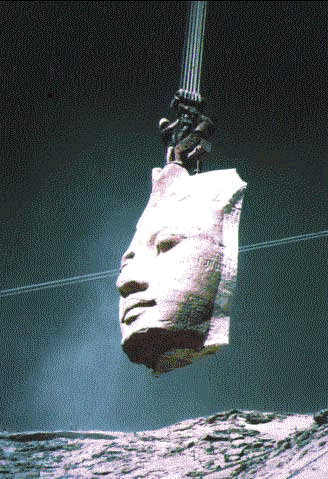
Moving Abu Simbel
Unfortunately, water (from moving the Nile around) is doing more damage to structures that can't be moved...
http://www.guardian.co.uk/science/story/0,,1702789,00.html?gusrc=rss\
New discoveries in Egypt all the time... even, sometimes, in places which have been very well studied:
e.g. The Valley of the Kings
http://www.thebanmappingproject.com/articles/
Used for over 500 years in the New Kingdom, Dynasties 18-20
(interesting article on later reuse of the Valley: http://www.thebanmappingproject.com/articles/article_2.4.html )
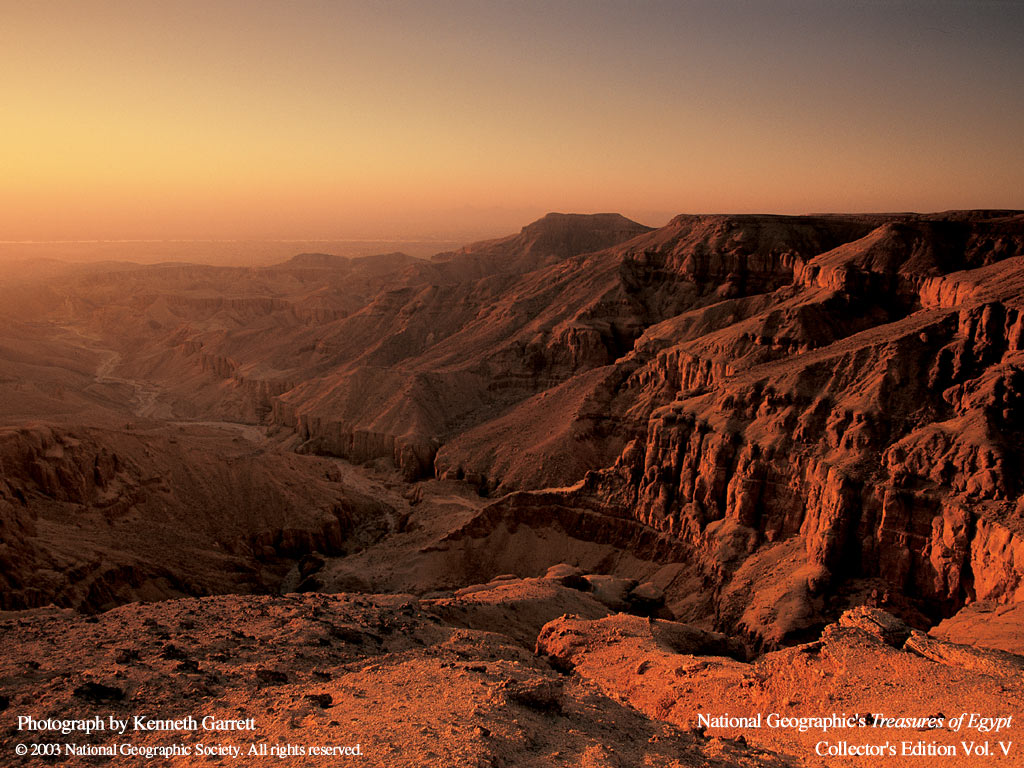

Theban Mapping Project: http://www.thebanmappingproject.com/
KV62 = Tutankhamun's tomb http://www.civilization.ca/civil/egypt/egtut01e.html , http://www.tutankhamun-exhibition.co.uk/
New neighbour: KV 63 discovered just recently:
article, http://news.bbc.co.uk/2/hi/middle_east/4700032.stm
Last big discovery in the area was the extent of KV5, in 1995: http://dsc.discovery.com/convergence/rameses/slideshow/slideshow.html
BURIAL RITES AND RELIGION
Predynastic: "Ginger" from the BM. 3400 BC, on display at BM since 1900.
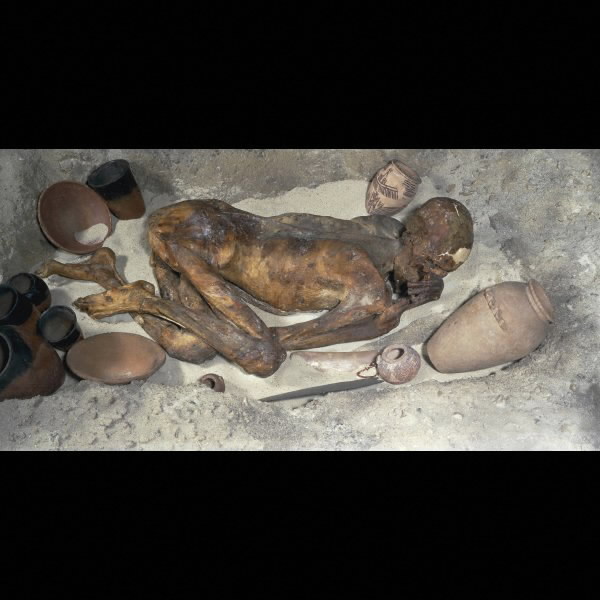
Later: Deliberate mummification.
n.b. they also mummified animals.
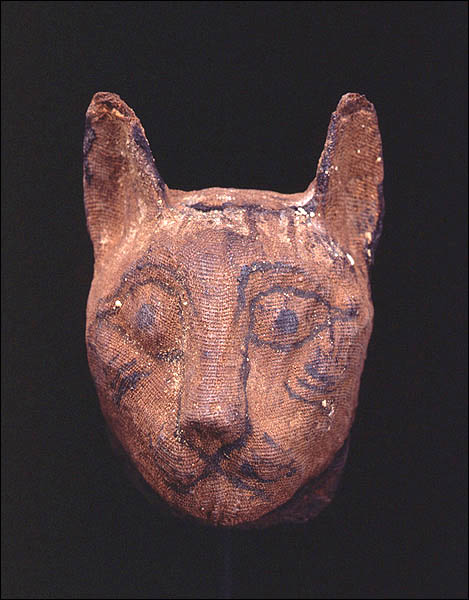
Want to adopt an animal mummy? You can! http://news.bbc.co.uk/1/hi/world/middle_east/1254835.stm
Want to be mummified? You can! http://www.summum.org/mummification/
Artifacts of mummification:
Bronze probe, inserted through the nose.

Canopic Jars: for storing internal organs with (but not in) the body.
Sons of Horus, four minor gods who protected the organs that they contained. They are: the falcon-headed Qebhsenuef (intestines); the jackal-headed Duamutef (the stomach); the baboon-headed Hapy (the lungs), and the human-headed Imsety (the liver).
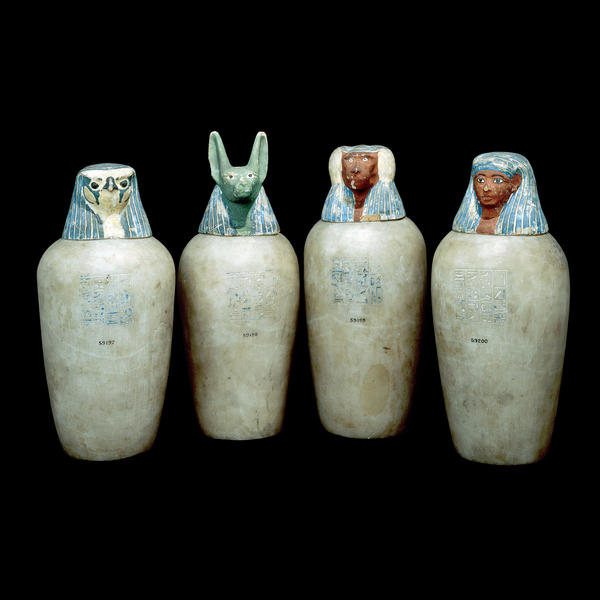
Scarab
New Kingdom, 1550-1069 BC
Amulet placed on the torso of the mummy, to protect the heart -- the seat of intelligence, emotion, and memory.

Beliefs
Why mummification?
Egyptian beliefs about life and death were very elaborate.
Death and rebirth – cyclical.
Elements of the individual that live on after death of body:
ba – linked closely to body – human-headed bird that journeyed to underworld – could die a second death
ka – individual’s twin self, vital force - memory of the deceased, and the physical representations that served to keep this memory active – ka could die a second death if forgotten
rn – the name
swt – the shadow
hk3 – personal magic
- death was a temporary state – the dead could affect the daily affairs of the living- letters to the dead were written and left at their tombs, e.g. a man asking his dead wife to intervene on his behalf with the Lords of Eternity.
So, the rituals:
1) public grief, and preparations of the body (up to 70 days) – mummification to make the body lifelike and lasting, a vehicle for the spirit if necessary – in New Kingdom Egypt, this resurrection took place every night
2) funeral – Opening of the Mouth ceremony, reanimation of the dead, ability to speak, but at the same time, the separation from the world of living
3) then maintenance of the dead in the afterworld, with continuing rituals at the tomb chapel, offerings of food etc. to sustain the dead one.
(Meskell 2002, Private Life in New Kingdom Egypt.)
The Ba

Ba, Egypt 2nd century AD.
BM. "The Egyptians believed that a person's essence or soul was composed of several elements. These became separated at death. The ba was one of the elements of the spirit, which encompassed the personality and emotions. It stayed close to the body of the deceased and was eventually reunited with other elements, to live eternally in the Afterlife"
Changing practices and representations
Roman Period Egypt, Mummy Mask, AD 100-170
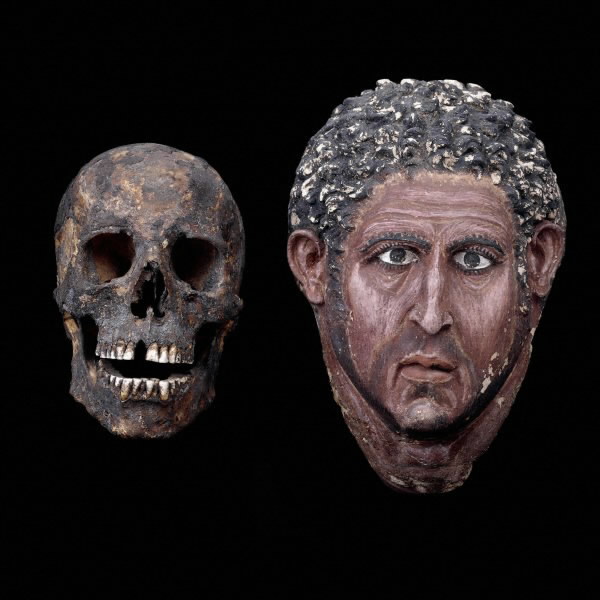
The Long Afterlife of Mummies...
- looting in antiquity
- C18-19 antiquarians and other uses, e.g. "mummy"
- current archaeology and public display
e.g. The Long Trip of Ramesses I
http://carlos.emory.edu/RAMESSES/
On October 26, 2003, the mummy that may well be Ramesses I returned to Cairo:
http://www.cbsnews.com/stories/2003/10/27/world/main580103.shtml
Religion
- creation myths... several, because of the fusion of multiple traditions (easy with polytheism)
e.g.
Heliopolis - watery swirling chaos called Nu... from which rose Atum, the sun god/goddess, who then created more god/desses by mating with his own shadow ... he spat out his son (Shu, air) and vomited up his daughter (Tefnut, moisture)... Shu and Tefnut produced Geb (earth) and Nut (sky) ... Geb and Nut produced Osiris, Isis, Seth, Nephthys
(fun version: http://www.ancientegypt.co.uk/gods/story/main.html )

- very interesting parallels with Christianity
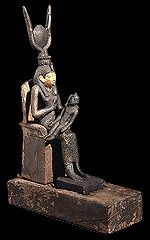 and
other religions (see Tom Harpur's book, The Pagan Christ)
and
other religions (see Tom Harpur's book, The Pagan Christ)
- continuity and change
- the case of the Amarna 'revolution' was only one upheaval, albeit the most dramatic... Amenhotep IV = Akhenaten Worhip of the Aten, the sun. Moved capital to Amarna. n.b. an attempt to introduce monotheism OR an attempt to consolidate power? general opinion says it was more about power and disempowering the priests, who were gaining too much political influence
- roles of priests - performing the necessary rituals for the gods and pharoahs... giving offerings, etc. not a pastoral/preaching kind of role
- religion and politics significantly intertwined... changes in one would affect the other...
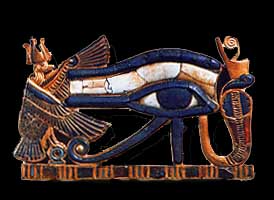
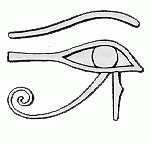 -
interesting aside... Eye of Horus. Horus was determined to avenge his
father's murder at the hands of his evil uncle Seth. Battle -- Horus' eye was
torn out and shredded into 64 pieces.. which Thoth healed... hence the eye of
Horus represents wellness and unity.... was then used by Galen (2nd century
Greek physician).... and then became the Rx sign.
-
interesting aside... Eye of Horus. Horus was determined to avenge his
father's murder at the hands of his evil uncle Seth. Battle -- Horus' eye was
torn out and shredded into 64 pieces.. which Thoth healed... hence the eye of
Horus represents wellness and unity.... was then used by Galen (2nd century
Greek physician).... and then became the Rx sign.

GODS
Not stable. Morphed and fused, in response to politics. e.g. Horus and Seth.
Many and varied! How to tell them apart? Their hats.
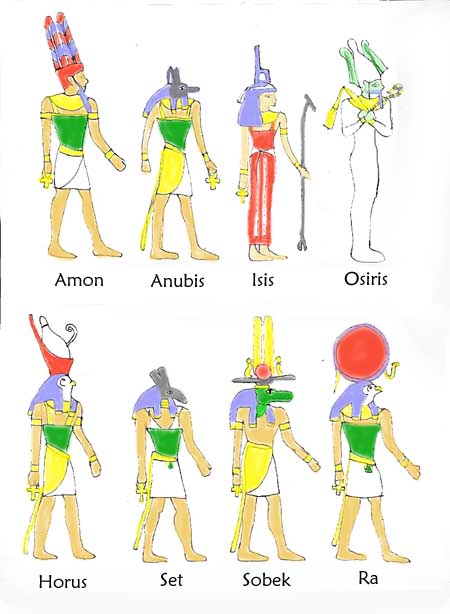
Amon - The creator god. Anubis - God of mummification.
Isis - Mistress of Magic. Also the wife of Osiris and mother of Horus.
Osiris - God of farming and ruler of the underworld.
Horus - The sky god. Son of Osiris and Isis.
Set - God of disorder. An enemy of Horus.
Sobek - The crocodile god.
Ra - The sun god.
Nice gallery here: http://www.exn.ca/egypt/thumbs.asp?cat=Art
HIEROGLYPHS:
the Greek word 'hieroglyph' means 'sacred' (hieros) and 'to carve in stone' (gluptein).
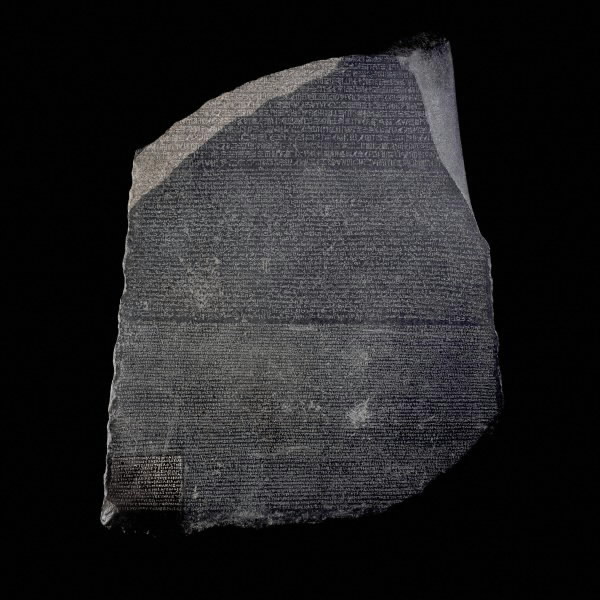
ROSETTA STONE
From Fort St Julien,
el-Rashid (Rosetta), Egypt
Ptolemaic Period, 196 BC
Now held in British Museum.
Writing also on papyrus, which preserves very nicely (e.g. below is a mathematical text from 1550 BC)
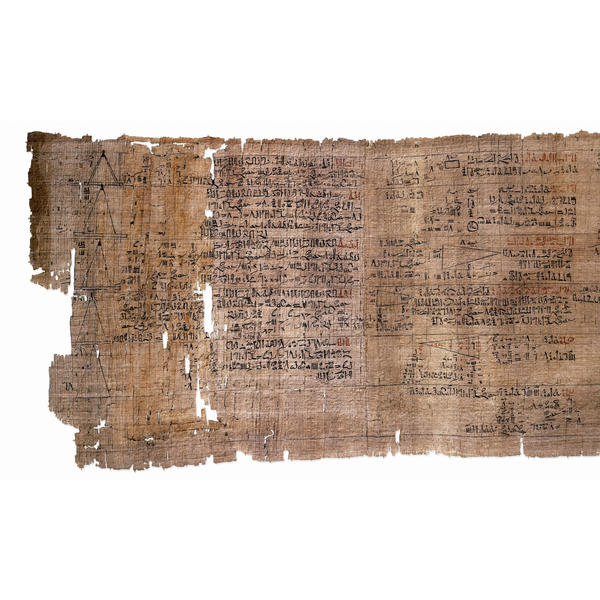
 Writing
in general
Writing
in general
- There are many different kinds of languages. Some are written down, and others aren't.
- There are different types of writing, and different ways of classifying those types!
First:
phoneme - smallest sound in a language, e.g. the "h", "i", "p" etc. in "hippopotamus"
syllable - a unit of spoken language larger than a phoneme, e.g. "hip" "po" "pot" "a" "mus"
word - a semantic unit, that is a unit of meaning, e.g. hippopotamus
picture - an image of something,
e.g.

referent - what a sign or word is referring to -- that is, a real hippopotamus
language - We also need to remember the difference between a language and an alphabet. With our alphabet, we can write many different languages; we can write English, or French, or Welsh, or Spanish, or whatever (with a few accents). Some other languages can be written using two different alphabets; for example, Serbo-Croat is a single language, but is written in either a Latin alphabet (ours), or a Cyrillic alphabet (like Russian).
So we could write the word "hippopotamus" in
lots of different alphabets
So, writing systems include:
logographic or pictorial systems - the symbols represent words or parts of words. Many are pictograms, i.e. look like the thing they represent. Sometimes represents the sound of a word, and sometimes represents the thing.
www.omniglot.com/writing/logographic.htm
syllabic systems - symbols for spoken syllables - these go together to replicate the sound of the word
alphabetic systems - 2 types - one with consonants only, and the other has consonants and vowels. one sign per sound (or phoneme)
-------------------------------
PUT ANOTHER WAY:
a) alphabetic
b) syllabic
c) logographic
d) pictographic
e) ideographic
These may be organized into groups:
Phonograms – signs indicating pronunciation
Alphabets – e.g. Latin, Greek, Phoenician
Syllabic – uses a syllabary, a set of signs which represent syllables
In contrast:
Logograms are signs representing a word but not indicating its pronunciation (e.g. $)
Pictograms are a simplified picture of the thing they represent (e.g. ☼ for sun)
Ideograms are signs representing an idea as a whole (e.g. an arrow pointing direction ↔ )
In addition:
Rebus – a transferred pictogram, used to represent something that sounds the same as what it’s depicting
Determinative – an ancillary sign which helps in the interpretation of a sign
| Writing system | Type:
Picture writing? Syllables? Alphabet? Combination? What is the sign referring to? |
What was
it written on? Role of writing in society?
How did archaeologists decipher it? |
| hieroglyphs | logographic - syllabic phonetic signs - express sounds and ideas n.b. no vowels so sometimes a word was ambiguous, so they added another sign (ideograms/determinatives/taxograms) - to tell specifically what the word is about www.omniglot.com/writing/egyptian.htm
|
decipherment - via Rosetta
Stone, which had three scripts written: Greek, hieroglyphic, and demotic.
Champollion knew the names of Ptolemy and Cleopatra from the Greek text,
and deduced their presence in the other texts. He knew Coptic, the
Egyptian descendant language, which was also very helpful.
|
| cuneiform | logographic - syllabic originally pictures, but then turned on their sides and simplified, and eventually came to represent syllables. Some determinatives also used. www.upenn.edu/museum/Games/cuneiform.html www.omniglot.com/writing/akkadian.htm www.mesopotamia.co.uk/writing/story/sto_set.html
|
deciphered because of inscriptions on Persian tombs which were written in three languages. |
| Chinese
|
logographic - stylized
pictures - each character represents a thing, but also a spoken syllable.
some determinatives used.
therefore minimum 3000 symbols needed to read modern Chinese! www.omniglot.com/writing/chinese.htm
|
a version of it still used today - therefore the knowledge was never totally lost |
For your Interest (not covered in class)
What makes an alphabetic writing system different from other writing systems is that it just represents very basic sounds; the images don't inherently mean anything or refer to anything in the real world. This is different from logographic systems/pictorial systems, in which a symbol represented a word/thing. It is also different from syllabic scripts, which have a different sign for each syllable. Thus, instead of hundreds or thousands of signs, you only need a couple of dozen (e.g. 26 signs in our alphabet). This makes them much simpler to learn and use. If you know the sounds of words, and you know how to write those sounds, you can (more or less) write words. Standardized spelling came later.
(e.g. word: Mesopotamia. Sound it out, letter by letter. Consider how else one could write this word, through pictures or syllables.)
The first alphabet was known as Protosinaitic, circa 1700 BC,
based on hieroglyphs. (Box 8.1, Fig 8.2). It was modified and became
Canaanite/Phoenician; this had 22 letters but no vowels. (
www.omniglot.com/writing/phoenician.htm)
From this derived the Hebrew alphabet and the Greek alphabet.
www.omniglot.com/writing/greek.htm) Many other alphabets (Latin, Etruscan,
other ancient Italian) are related to the Greek, but the lines of relationship
aren't quite clear. The Greek alphabet was the first to use vowels, and has thus
often been regarded as the basis for most other alphabets. However, lines of
influence also came directly from the Phoenician.
Our own alphabet is known as the Latin/Roman alphabet, which first started to take shape in the 6th century BC. www.omniglot.com/writing/latin.htm It is derived from the Etruscan alphabet.
Frequently asked question about Coptic: The Coptic alphabet emerged after the
Greek conquest of Egypt. The actual Coptic language is simply the ancient
Egyptian language -- the word "Coptic" is based on the later Arabic term for
"Egyptian". The writing system in Egypt before the Greek conquest was demotic
script (which was a late Egyptian script, derived from hieroglyphic and
hieratic). Thus the Coptic alphabet is a fusion of the native Egyptian script
and the invaders' Greek alphabet. Coptic combines 7 demotic letters with the
standard Greek letters. (www.omniglot.com/writing/coptic.htm)
The ancient Egyptian language was spoken from about 4,000 BC until the 11th
century AD, whereupon it was replaced by Arabic for usual daily life. The
ancient Egyptian language is still used by the Coptic Church in Egypt, however
-- much as Latin is used in the Roman Catholic Mass.
Fun link: want to write your name in a bunch of different languages? http://www.omniglot.com/links/yournamein.htm
But what are the different implications of writing systems?
Different systems allow you to do different things.
Some early writing systems were not very grammatical -- they were more like a short-hand which would help people remember things, rather than precise sentences.
But if you live in a primarily oral culture... do you need full literacy like we have today?
What about multilingual inscriptions like the Rosetta Stone or the tomb of Darius? Why write in more than one language? (obviously it has been helpful to archaeologists, but that wasn't why they did it!)
What does it mean when your writing system no longer directly represents anything from the real world?
Knowing ancient peoples through language
What successful decipherment usually requires
The challenge of layers: Representation upon representation, meaning over meaning
Denaturalizing writing:
A writing system changes diachronically and varies synchronically
Writing is held to be sacred in origin, in many traditions
Writing was long held to be tremendously powerful in itself
What Successful Decipherment Usually Requires...

Successful decipherment usually requires:
- accurate copies
- a familiar language
- proper names of figures known in neighbouring cultures
- bilingual or multilingual inscriptions
(Daniels and Bright 1996:142-3)
Classic examples of
multilingual inscriptions: The Rosetta Stone (hieroglyphic, demotic,
Greek), and the Behistun Inscription, Iran (Persian, Elamite, Babylonian).

Rosetta Stone image from British Museum Compass collections online
Behistun cuneiform: http://mcadams.posc.mu.edu/txt/ah/Persia/cunifo_e.gif
Closer view of the Rosetta stone: http://www.bgst.edu.sg/realia/rosetta.htm
 Counter-example:
Hieroglyphic and Demotic... but not saying the same thing!
Counter-example:
Hieroglyphic and Demotic... but not saying the same thing!
Stela fragment of Horiraa, From Memphis, Egypt, 30th Dynasty to early Ptolemaic Period (380-200 BC) Image from British Museum Compass collections online.
Decipherment requires moving past preconceptions:

Example: Mayan glyphs
"The Fenton Vase": Polychrome, Late Classic (AD 600-800), Nebaj, Guatemala
image from British Museum Compass collections online.
Diego de Landa's Mayan "alphabet"... which turned out to be only part of the system.

Image from: Harris, Roy. 1986. The Origin of Writing. London: Duckworth.
The Rebus Principle - "whereby a word that cannot easily be written is represented by a word or words that have the same sound and can easily be written" (Marcus 1992:65)

Image from Marcus, Joyce. 1992. Mesoamerican Writing Systems: Propaganda, Myth, and History in Four Ancient Civilizations. Princeton: Princeton University Press. p 65
More shedding of alphabetic preconceptions: Egyptian hieroglyphs combine pictograms, logograms, ideograms, phonograms, and determinatives.
Reading Hieroglyphs
(n.b. also hieratic and demotic)
- hieroglyphs - 3100 BC to 300 AD
- originally thought to be symbolic
- although most are pictures of plants, animals, equpment, they mean sounds
- when a sign actually means the image, a determinative stroke is used
- no vowels so our pronunciation is a tad fictitious
- determinatives are silent (e.g. for names... male - seated man... female - seated woman)
- include
- phonograms (sound signs) - alphabetic, biliteral, triliteral
- ideograms (sense signs) - logograms and determinatives (to distinguish words otherwise identical n.b. no vowels, also as word dividers)
- n.b. a single hieroglyph can vary in function
- direction
- organization - aesthetics and symmetry - Egyptians liked rectangles, avoided blanks and gaps, would adjust size, direction, and orientation to make it pretty

Image from Marcus, Joyce. 1992. Mesoamerican Writing Systems: Propaganda, Myth, and History in Four Ancient Civilizations. Princeton: Princeton University Press. p 25
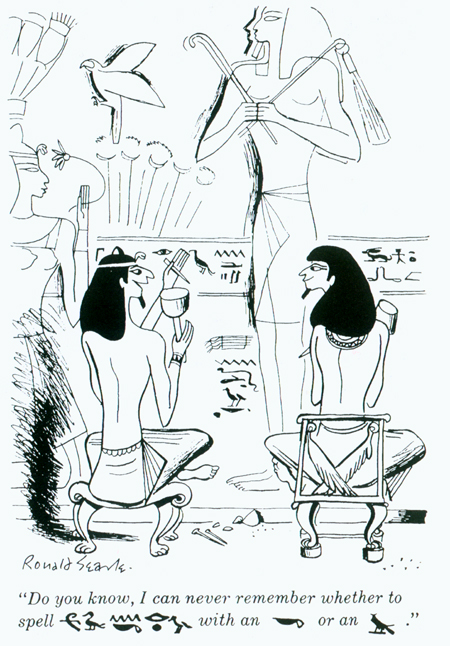
"I can never remember how to spell...."
But that would be okay... since there were often many ways of visually representing the same spoken word.
Illustration by Ronald Searle.
Image source: Parkinson, Richard. 1999. Cracking Codes: The Rosetta Stone and Decipherment. London: British Museum p 151
A Mayan hieroglyph may include several "affix" signs around the main sign. This is the emblem glyph for Palenque.

Image from Marcus, Joyce. 1992. Mesoamerican Writing Systems: Propaganda, Myth, and History in Four Ancient Civilizations. Princeton: Princeton University Press. p 86
Six ways of writing the same Mayan name -- Lord Shield, aka Pacal -- using combinations of logograms and phonograms.

Image from Marcus, Joyce. 1992. Mesoamerican Writing Systems: Propaganda, Myth, and History in Four Ancient Civilizations. Princeton: Princeton University Press.
Undeciphered Scripts


Left: Tartaria amulet - Romania c 4500 BC - example of Vinča script, undeciphered.
Above: The Rongorongo script of Easter Island, undeciphered.
Images borrowed from http://en.wikipedia.org/wiki/Image:Tartaria_amulet.png and http://www.rongorongo.org/repro/kr.html


Examples of the undeciphered Indus Valley script.
The "Unicorn Seal" of fired steatite, from Mohenjo-daro, c. 2000 BCE and another seal impression.
Images borrowed from http://www.harappa.com/seal/seal1.html and http://www.harappa.com/seal/seal3.html

And for something completely different... the Quipu or Khipu... potentially a method of binary coding.

Images borrowed from Gary Urton's 2003 book, Signs of the Inka Khipu: Binary Coding in the Andean Knotted-String Records. Austin: University of Texas Press.
Denaturalizing writing some more... (skipped this section in class)
A writing system changes diachronically and varies synchronically

e.g. Evolution of Kanji - one of three different scripts used in Japanese - origins in China, introduced via Korea.
e.g. Evolution of cuneiform

Same words, same script, merely different styles.......


tHE cHALLENGE of layers: Representation upon representation, meaning over meaning
(skipped this section in class)


Assyrian relief with cuneiform: "A winged deity pollinating stylized trees, symbolizing fertility. This is an alabaster relief from the Northwest Palace of King Assur-nasir-pal II at Nimrud." Brooklyn Museum.
Images from Gordon, Cyrus. 1968. Forgotten Scripts: How they were deciphered and their impact on contemporary culture. New York: Basic Books.
Mayan relief from Yaxchilan

Yaxchilán lintel 24: Shield Jaguar II, and his wife, Lady K'ab'al Xook. AD 709
image from British Museum Compass collections online.
Aztec Conventions of Representation in the Codex Mendoza

Image from: Ross, Kurt. 1978. Codex Mendoza: Aztec Manuscript, with commentary. Miller Graphics. p 41

Image from: Ross, Kurt. 1978. Codex Mendoza: Aztec Manuscript, with commentary. Miller Graphics. p 38

Image from: Ross, Kurt. 1978. Codex Mendoza: Aztec Manuscript, with commentary. Miller Graphics. p 28
Image from: Ross, Kurt. 1978. Codex Mendoza: Aztec Manuscript, with commentary. Miller Graphics. p 117
Writing is held to be sacred in origin, in many traditions.


Among the ancient Egyptians, the inventor/donor of writing was held to be the god Thoth (depicted either as ibis-headed man or as a baboon, often associated with the moon).
Quartzite Baboon figure, possibly representing Thoth, Egypt, 18th Dynasty, circa 1350 BCE.
Image from British Museum Compass collections online.


In China, the (mythical?) sage-emperor Fu Hsi is often given credit for inventing writing and animal husbandry. Sometimes credit goes to his contemporary, the historian Ts'ang Chieh instead.
In Hinduism, the elephant-headed Ganesh is the god of writing (and wisdom and luck and doorways).
Ganesha - Ivory, 14th-15th century, India.
Image borrowed from: http://www3.la.psu.edu/courses/worldreligions/arts-hinduism.htm

In Judaeo-Christian tradition, "The Ten Commandments" were the first writing - also from a divine source.
Tablets image borrowed from: www.catholicsupply.com/christmas/walldecor.html
Charlton Heston image from http://charltonhestonworld.homestead.com/files/CH-Moses7.JPG
Writing was long held to be tremendously powerful in itself.
In some cases, even a written word was believed to heal or curse... hence the high value of books once upon a time.

" He who takes this book away/ On a Paris gallows will sway
If he's not hanged, he'll be drowned/ If he's not drowned, he'll be burned,
And if he's not burned/ He'll a worse end have earned"
Quotation and Image from Drogin, Marc. 1989. Biblioclasm: The Mythical Origins, Magic Powers,
and Perishability of the Written Word. Savage, Maryland: Rowman and Littlefield, pp 124
Links:
British Museum: http://www.ancientegypt.co.uk/menu.html
Saqqara: http://www.culture.gouv.fr/culture/arcnat/saqqara/fr/intro_flash.htm
Egyptian art: http://www.metmuseum.org/explore/new_pyramid/PYRAMIDS/HTML/el_pyramid_Intro.htm
Eternal Egypt: http://www.eternalegypt.org
http://www.digitalegypt.ucl.ac.uk/Welcome.html especially
http://www.digitalegypt.ucl.ac.uk/religion/index.html
http://www.sacred-texts.com/egy/ebod/index.htm
http://www.sacred-texts.com/egy/pyt/index.htm